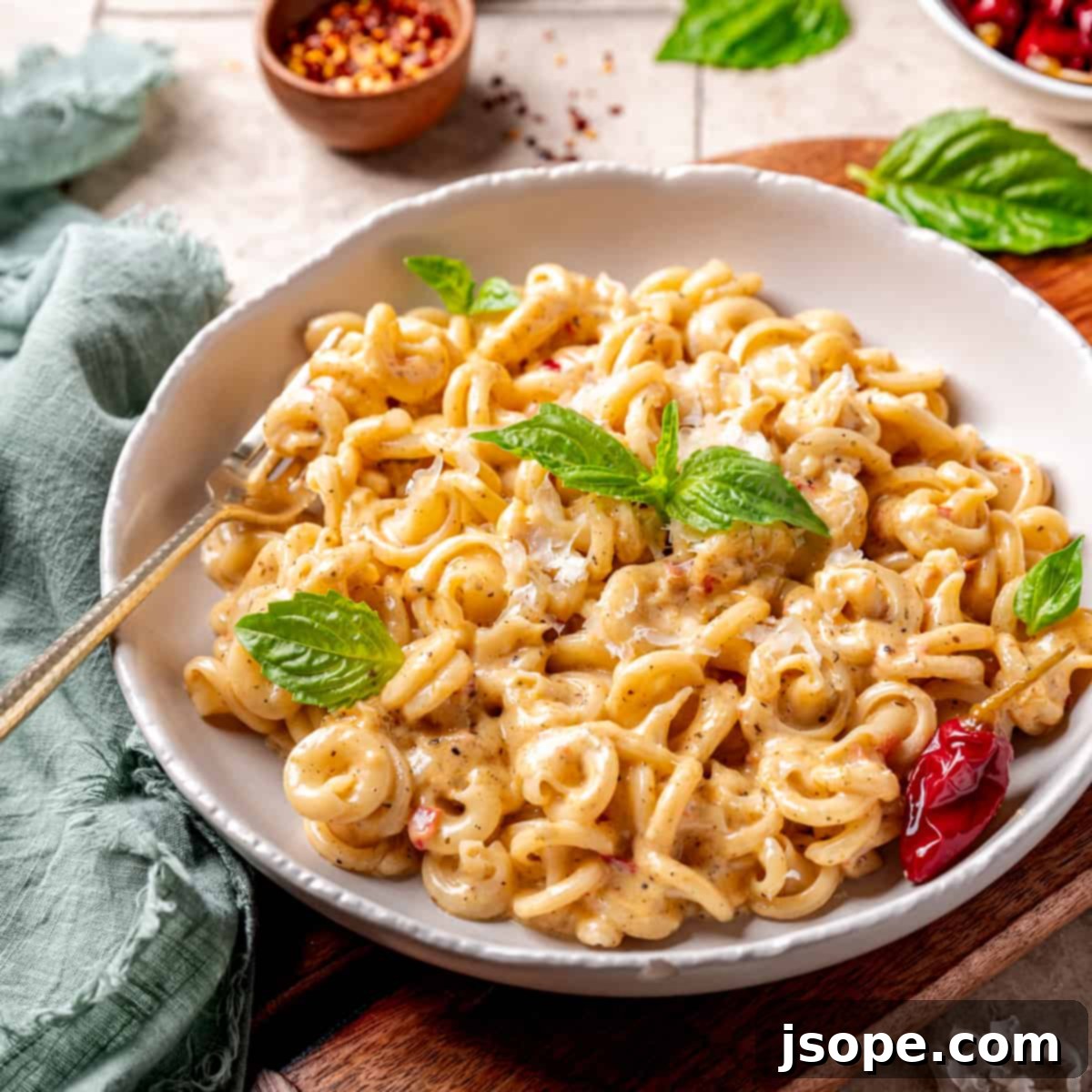Welcome to a culinary dream for aficionados of rich, spicy cream sauces! We embarked on a mission to craft a dish that marries the luxurious texture of an American-style creamy Alfredo with the vibrant, fiery kick of classic Italian Calabrian chili peppers. The goal was simple: an extraordinary flavor experience that’s also incredibly easy and quick to prepare, perfect for any busy weeknight. This recipe for Spicy Calabrian Chili Alfredo Sauce with Trottole Pasta is an undeniable winner, promising to become a cherished favorite in your kitchen.

While this dish offers a delightful modern twist, we also celebrate the roots of Italian cuisine. If you’re seeking a more traditional Italian fettuccine Alfredo, made solely with butter and Parmigiano-Reggiano without cream, you might enjoy our Fettuccine Alfredo with Mushrooms (No Cream). For those who adore creamy pasta sauces, similar to this indulgent creation, be sure to explore our Shrimp Orecchiette with Lemon Garlic Cream Sauce or our luscious Creamy Cacio e Pepe Pasta.
What is Alfredo Sauce? Unraveling Its Rich History
The story of Alfredo sauce is a fascinating journey from classic Italian simplicity to global culinary stardom. The original, authentic Alfredo sauce, a masterpiece of minimalism, was conceived by Alfredo De Lelio in Rome. This traditional Italian preparation, known as fettuccine al burro (fettuccine with butter), features just three core ingredients: fresh fettuccine pasta, high-quality butter, and finely grated Parmigiano Reggiano cheese, emulsified with a touch of pasta cooking water. The magic lies in the quality of ingredients and the technique, creating a light yet incredibly flavorful sauce that coats the pasta beautifully.
However, when Italian immigrants brought this beloved dish to the United States, culinary adaptations naturally occurred. The availability of genuine Parmigiano Reggiano was limited, and American butter typically had a lower fat content than its European counterparts. To achieve a similar richness and luxurious mouthfeel, American cooks introduced heavy cream to the recipe. Furthermore, garlic, a staple in many Italian-American dishes, was often added to enhance the flavor profile. This evolution led to the “American-style” Alfredo sauce, a creamy, garlic-infused delight that has become incredibly popular and, in many parts of the world, is now more widely recognized than its Italian ancestor. We wholeheartedly embrace both versions, appreciating the distinct characteristics each brings to the table. Both the traditional and the Americanized Alfredo sauce recipes offer unique and deeply satisfying culinary experiences.
A quick word of advice on store-bought jarred Alfredo sauces: while convenient, they often contain a long list of unnecessary ingredients, preservatives, and artificial flavors to achieve shelf stability. The truth is, homemade Alfredo sauce is remarkably easy and quick to prepare, yielding a far superior taste and texture without any unwanted chemicals. Once you taste the difference, you’ll understand why skipping the jar is always the best choice.
Why You’ll Fall in Love with this Recipe
- It’s exceptionally quick and easy to make, perfect for those evenings when you crave a gourmet meal without the lengthy preparation.
- Requires just a handful of accessible ingredients, ensuring a straightforward shopping list and simple cooking process.
- You can effortlessly double or even triple the recipe to feed a larger crowd or prepare delicious leftovers for the week.
- It’s incredibly filling and deliciously satisfying, substantial enough to stand alone as a complete and comforting meal.
- Boasts a bold, memorable flavor with the perfect amount of kick, thanks to the star ingredient: Calabrian chili paste.
Essential Ingredients for Your Spicy Alfredo Masterpiece
Crafting this spicy Alfredo sauce requires a selection of high-quality ingredients, each playing a vital role in achieving the perfect balance of creaminess, flavor, and heat:

- Unsalted Butter: The foundation of any great cream sauce. If possible, seek out “European-style” butter, which is typically cultured and boasts a higher butterfat content (at least 82%). This extra richness contributes significantly to the sauce’s luxurious texture and flavor. However, if not available, any good quality unsalted butter will work beautifully.
- Fresh Garlic: Minced fresh garlic cloves are indispensable in cream-based Alfredo recipes, providing an aromatic depth that complements the richness of the sauce without overpowering it. Always opt for fresh over pre-minced for the best flavor.
- Heavy Cream: This is where the sauce gets its signature silky, thick consistency. High-quality heavy cream (often labeled as heavy whipping cream) is crucial here; avoid half-and-half or milk if you want that truly decadent Alfredo texture.
- Italian Seasoning: A blend of dried herbs that adds a wonderful layer of classic Italian flavor. You can use your favorite store-bought blend, or if you’re feeling adventurous, mix your own (typically includes oregano, basil, thyme, rosemary, and marjoram).
- Calabrian Chili Peppers: These are the secret to this sauce’s vibrant, spicy twist. Calabrian chilies are celebrated for their unique flavor profile: a balanced heat with fruity, smoky, and slightly sweet undertones. They can often be found online, either whole or, more conveniently for sauces, crushed in olive oil paste. Look for them in specialty Italian food sections or the jarred condiment aisle of larger grocery stores. The paste or crushed version is ideal for smooth integration into the sauce, but whole peppers can be finely diced if preferred.
- Kosher Salt and Freshly Ground Black Pepper: Essential seasoning agents that enhance all the other flavors. Seasoning to taste is key, especially with the salty Parmigiano Reggiano.
- Parmigiano Reggiano: This “King of Cheeses” is non-negotiable for an authentic and flavorful Alfredo. Look for genuine Parmigiano Reggiano imported from Italy, identifiable by the DOP (Denominazione d’Origine Protetta) stamp on the rind. For optimal creaminess in the sauce, choose a younger wheel (around 12 months aged), as these are softer and melt more smoothly. Critically, grate your own cheese fresh! Pre-grated cheeses often contain anti-caking agents like cellulose, which can lead to a grainy or clumpy sauce instead of a smooth, velvety one. Freshly grated cheese also offers superior moisture content and flavor.
- Trottole Pasta: This charming, short pasta shape is named after a “spinning top” due to its spiraled form. Its unique design is perfect for catching and holding every drop of the rich, creamy Alfredo sauce, ensuring a flavorful bite every time.
Refer to the recipe card below for precise quantities.
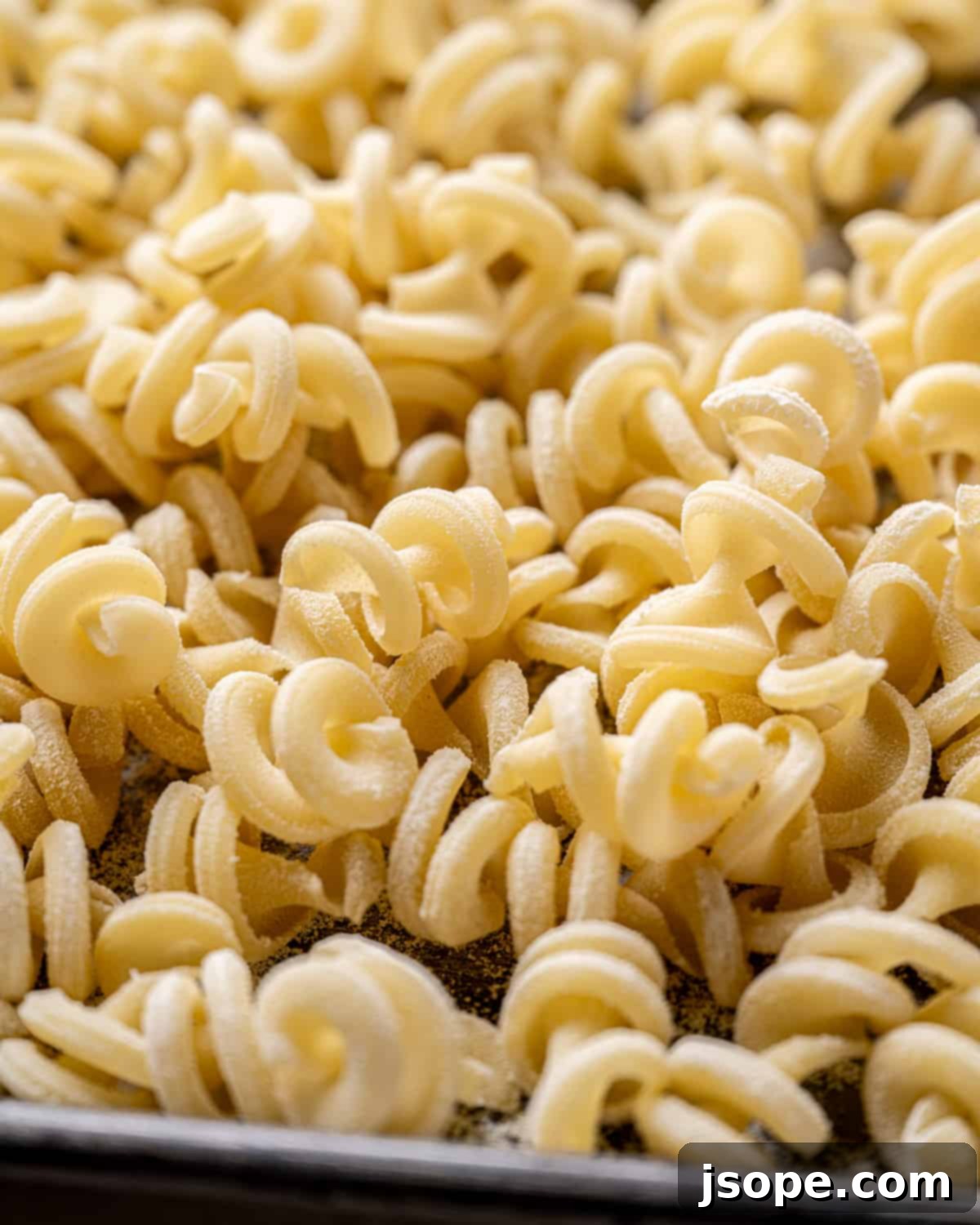
Smart Substitutions to Adapt Your Recipe
Should you need to make adjustments, here are a few common substitutions that work well for this recipe:
- Parmigiano Reggiano: If authentic Parmigiano Reggiano is unavailable or outside your budget, several excellent Italian cheeses can step in. Pecorino Romano, a salty sheep’s milk cheese, offers a sharper flavor and can be used, provided it’s not too highly aged (which can make it excessively hard and less suitable for melting smoothly). Grana Padano is another fantastic alternative, similar in texture and flavor to Parmigiano Reggiano, and often more accessible.
- Calabrian Chili Peppers: While we highly recommend the distinctive flavor of Calabrian chilies, if you can’t source them, you have several options to introduce heat. Crushed red pepper flakes are a readily available and effective way to add spice, though they lack the fruity, smoky notes of Calabrian chilies. Other chili pastes, a not-too-vinegary hot sauce, or a pinch of cayenne pepper can also provide heat. For a unique twist, consider making a homemade Cajun Alfredo sauce using our homemade Cajun seasoning blend.
- Italian Seasoning: Fresh herbs always elevate a dish. Replace the dried Italian seasoning blend with a combination of finely chopped fresh oregano, basil, and rosemary for a brighter, more vibrant flavor.
- Trottole Pasta: Don’t limit yourself to trottole! This sauce pairs wonderfully with almost any pasta shape. We particularly favor shapes with nooks, folds, or tubes that excel at capturing creamy sauces, such as penne, rigatoni, orecchiette, or even classic fettuccine. Feel free to experiment with your favorite pasta to find your perfect match.
Crafting Your Spicy Calabrian Chili Alfredo Sauce with Trottole Pasta
This dish is remarkably simple to prepare, making it ideal for a quick yet impressive meal. The process involves bringing the velvety sauce together in one pan while your pasta cooks simultaneously. Once the pasta is perfectly al dente, it’s transferred directly into the sauce, tossed to ensure every piece is coated, and then served immediately. It’s truly super simple and incredibly delicious!
Essential Equipment for Success
To prepare this delightful pasta dish, you’ll need just a few basic kitchen tools:
- A large pot for cooking the pasta
- A large frying pan or sauté pan for preparing the sauce
- A whisk to ensure a smooth, lump-free sauce
Step-by-Step Instructions for a Perfect Dish
Follow these easy steps to create your unforgettable Alfredo pasta:
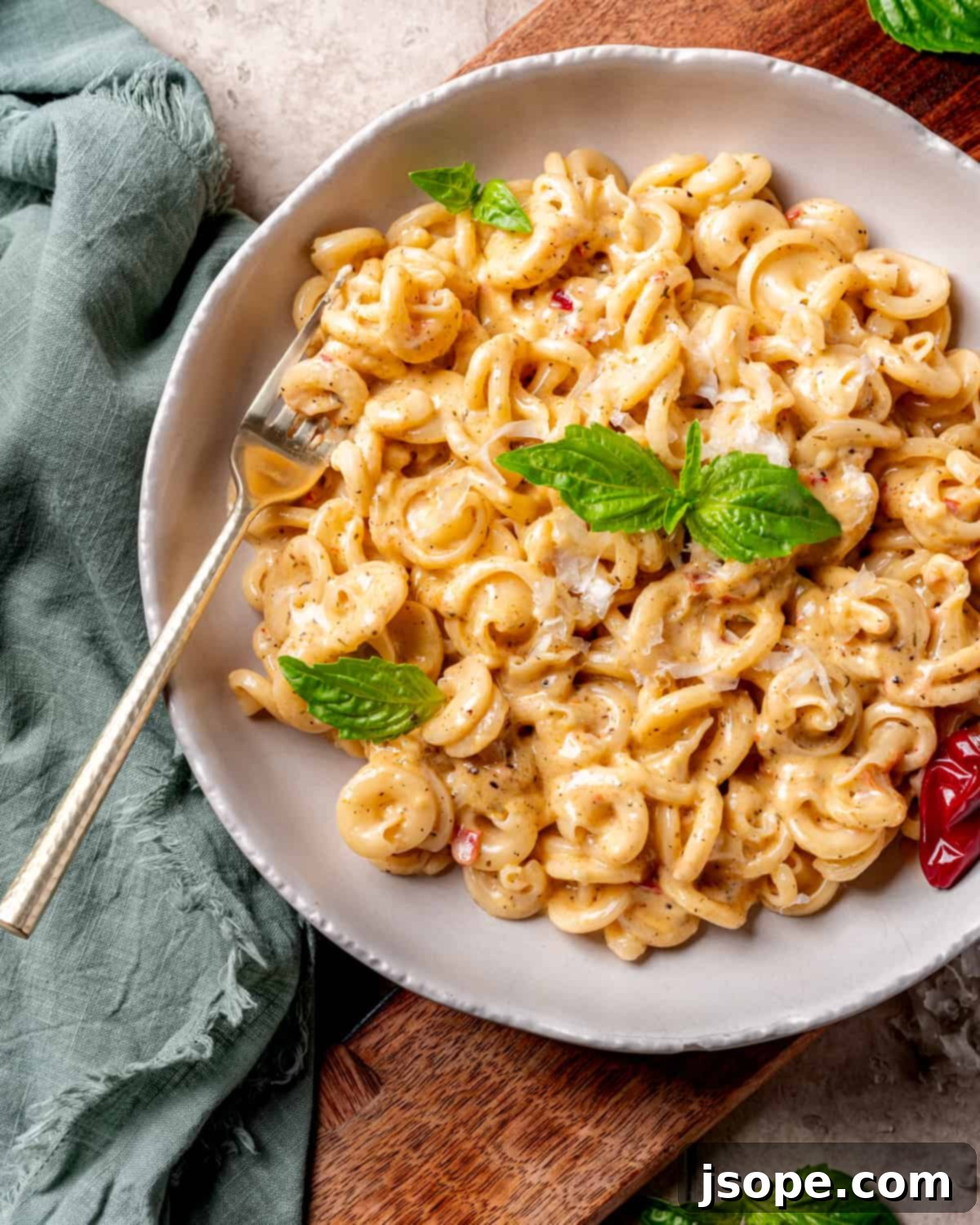
Step 1: Prepare the Pasta Water
- Begin by bringing a large pot of generously salted water to a rolling boil. While the water heats up, you can start preparing your flavorful sauce.
Step 2: Develop the Sauce Base
- In a large frying pan over medium heat, melt the unsalted butter. Once melted, add the minced garlic and cook gently for 1-2 minutes until fragrant, being careful not to let it brown, as this can make it bitter.
- Whisk in the heavy cream, Italian seasoning, Calabrian chili paste, and ground black pepper. Bring the mixture to a gentle simmer, then reduce the heat to medium-low. Continue to simmer, stirring frequently, for approximately 5 minutes to allow the flavors to meld and the sauce to slightly thicken.
Step 3: Achieve Ultimate Creaminess with Cheese
- Remove the pan from the heat and let it rest until the simmering stops completely. This crucial step prevents the cheese from becoming grainy. Vigorously whisk in the grated Parmigiano Reggiano. Return the pan to very low heat, continuing to whisk constantly for about 1 minute until the cheese is fully melted and the sauce is wonderfully smooth and velvety. Cook for another 2 minutes, then taste and add additional salt if needed.
Step 4: Cook the Pasta to Perfection
- Add a generous amount of salt to the boiling pasta water – it should taste distinctly salty, like the sea (approximately 2 tablespoons for every 6-8 quarts of water). Cook the trottole pasta according to package directions until it is perfectly al dente, meaning it’s firm to the bite but cooked through. Just before draining, scoop out about a cup of the starchy pasta cooking water and set it aside.
Step 5: Combine and Serve
- Once the pasta is cooked, drain it thoroughly and immediately transfer the hot pasta directly into the pan with the prepared Alfredo sauce. Toss everything together vigorously to ensure every strand of pasta is thoroughly coated with the rich, spicy sauce. If the sauce appears too thick, add the reserved pasta water, a tablespoon at a time, until your desired consistency is achieved. Serve hot, garnished with fresh basil if desired, and enjoy!
Delicious Variations to Customize Your Meal
Feel free to get creative with this recipe and explore these delightful variations:
- Elevate with Protein: For a heartier meal, incorporate your favorite protein. Sliced grilled chicken breasts are a popular American addition, providing excellent flavor and substance. Alternatively, shrimp makes for a fantastic pairing; cook the shrimp about 75% of the way through separately, then add it to the sauce a minute before incorporating the cheese, or simply serve perfectly grilled or sautéed shrimp on top of the plated dish.
- Experiment with Pasta Shapes: The beauty of this sauce is its versatility. While trottole is excellent, don’t hesitate to use other pasta shapes. Anything from penne and rigatoni to fusilli or even classic spaghetti can be transformed by this flavorful sauce.
- Lighten it Up: If you prefer a slightly lighter sauce, you can substitute whole milk for some or all of the heavy cream. Be aware that the sauce will be thinner. If you desire a thicker consistency, create a quick slurry by mixing 1 teaspoon of cornstarch with 2 teaspoons of cold water until smooth, then whisk it into the simmering sauce. Bring it back to a simmer to thicken.
- Adjust the Spice Level: The amount of Calabrian chili paste can be easily adjusted to your preference. For a milder kick with just a hint of heat, use 2 teaspoons. If you’re a true spice lover and enjoy a little sweat on your brow, feel free to add more than the recommended tablespoon plus a teaspoon. For a classic, non-spicy Alfredo, simply omit the Calabrian chili peppers entirely.
If you’ve fallen in love with Calabrian chili peppers, just like we have, be sure to try our Fava Bean Agnolotti del Plin with Calabrian Chili Butter Sauce or our vibrant Goat Cheese Pesto and Asparagus Pizza, both featuring this incredible ingredient!
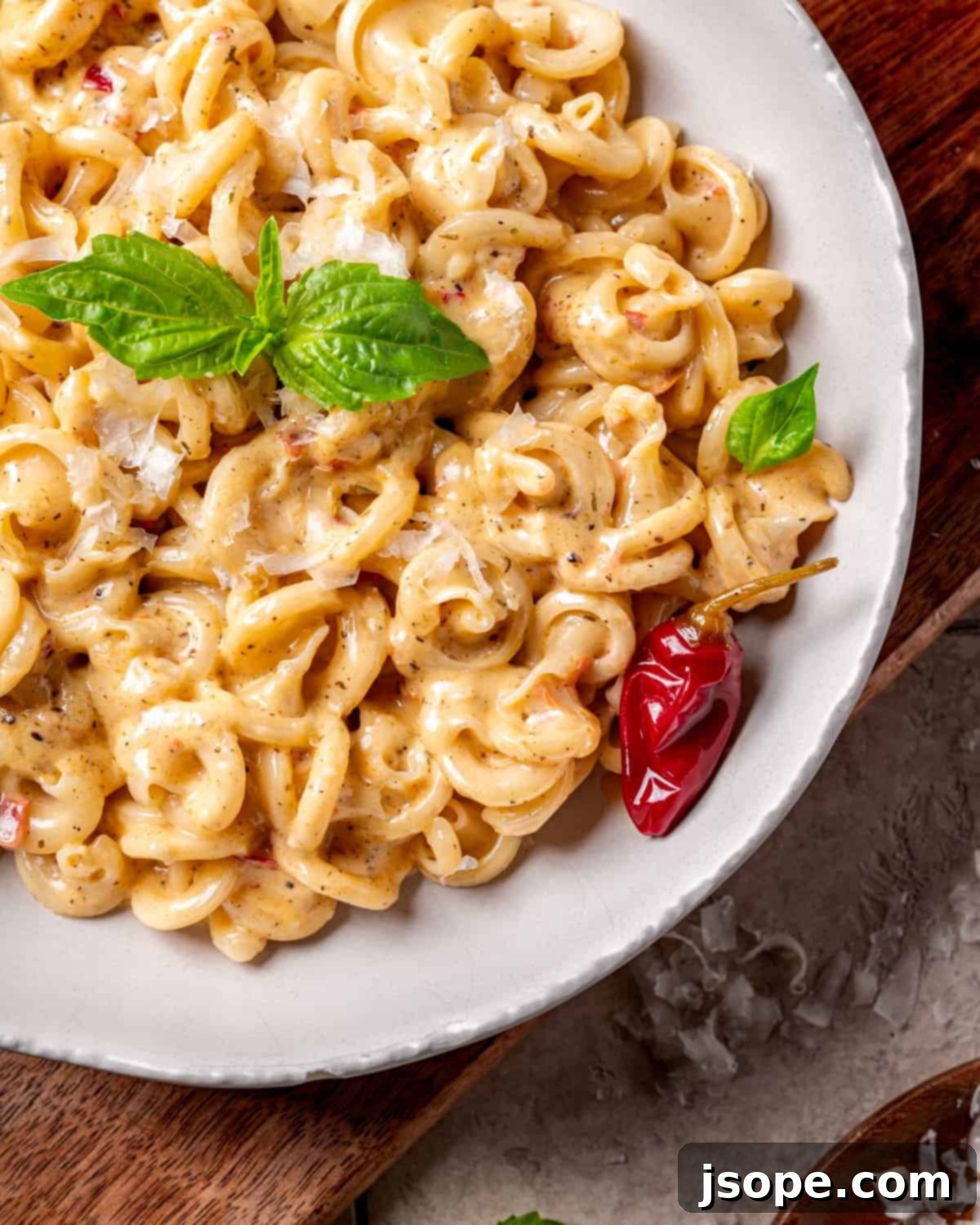
Storage and Reheating Tips for Leftovers
Proper storage ensures you can enjoy your delicious spicy Alfredo pasta later:
- Storing Leftovers: For the best quality, it’s generally recommended to store any leftover sauce separately from the pasta. The sauce, when stored in an airtight container, will keep well in the refrigerator for up to 5 days. When you’re ready to enjoy it again, simply cook fresh pasta and reheat the sauce.
- Reheating Alfredo Sauce: Cream-based sauces are delicate and prone to separating if reheated too quickly or at high temperatures. Reheat your Alfredo sauce gently on the stovetop in a saucepan over very low heat. Stir or whisk frequently until the sauce is heated through and smooth again. Patience is key here!
- Freezing Alfredo Sauce: Freezing cream-based sauces is generally not recommended. The dairy fats tend to separate upon thawing and reheating, often resulting in a grainy or broken texture that is difficult to restore. Given how easy and quick this sauce is to make fresh, it’s best to enjoy it within its refrigerated shelf life and simply prepare a fresh batch next time.
Top Tip for a Perfect Sauce
Once you’ve added the heavy cream to your sauce, resist the urge to crank up the heat! Gentle simmering over medium-low heat is crucial. Be patient; the sauce only needs about 7 minutes of cooking time to thicken slightly and for the flavors to develop beautifully. High heat can cause the cream to scorch or the sauce to separate.
Common Issues and Quick Fixes
While this recipe is straightforward, occasional issues can arise. Here’s how to troubleshoot them with ease:
Sauce too thick? It’s always a good habit to reserve a cup of starchy pasta water just before your pasta finishes cooking. If your Alfredo sauce turns out thicker than desired, simply add the reserved pasta water, a tablespoon at a time, whisking continuously until the sauce reaches your preferred silky consistency.
Sauce too thin? This is a less common issue with cream-based Alfredo sauces, but if it occurs, you can easily thicken it. Prepare a quick slurry by combining 1 teaspoon of cornstarch with 2-3 teaspoons of cold water; mix well with your finger until completely smooth. Whisk this slurry into the sauce and bring it to a gentle simmer, stirring, until it thickens. Remember, always add the slurry *after* the cheese has been incorporated.
Need to adjust seasoning? We strongly recommend waiting until the very end to add extra salt. Parmigiano Reggiano cheese is inherently salty, and the exact saltiness can vary between brands or ages. Additionally, personal preference for saltiness differs. Once all ingredients are combined in the sauce, taste and adjust the kosher salt to your liking.
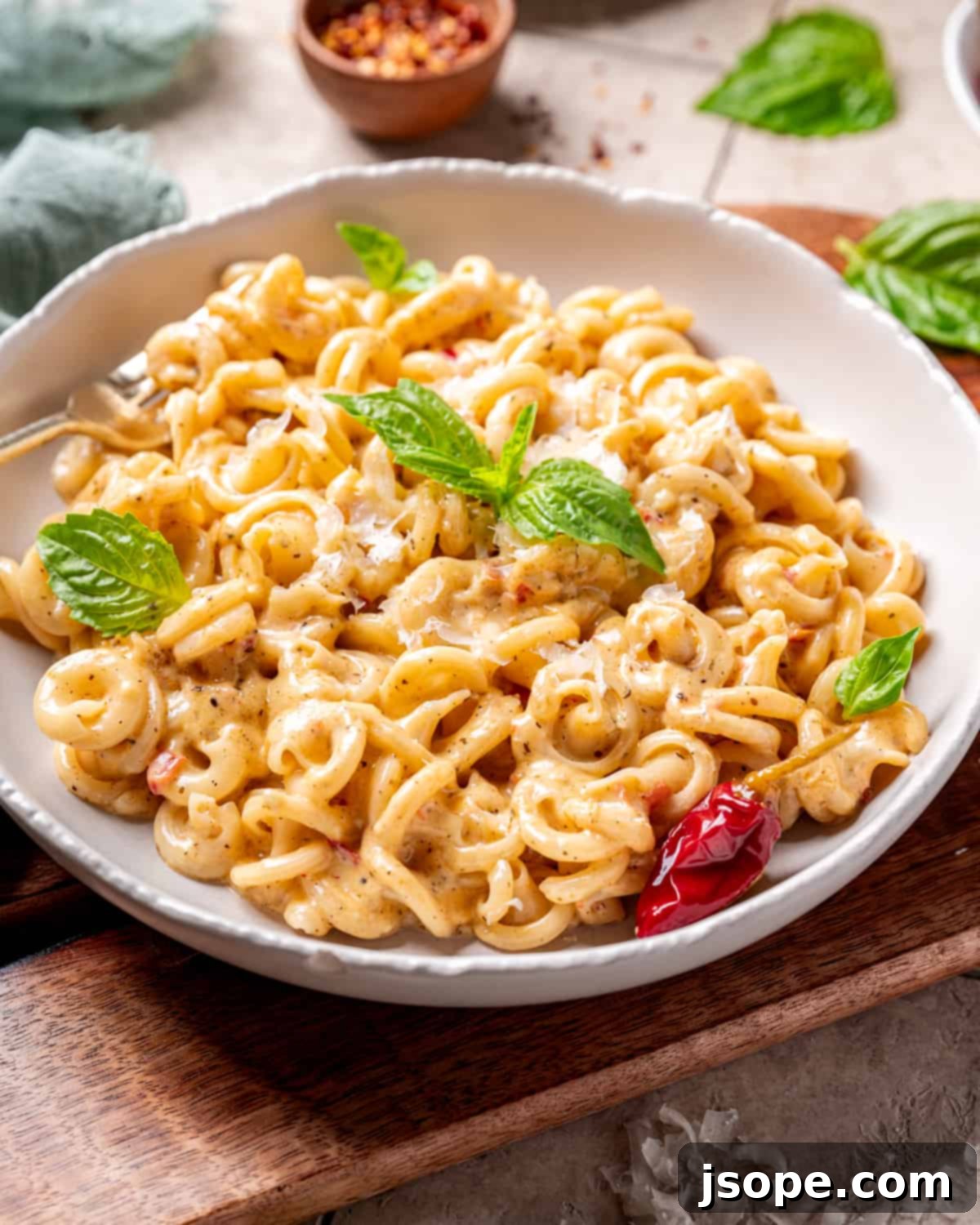
What to Serve with Spicy Calabrian Chili Alfredo Pasta
This versatile pasta dish can be the star of your meal or a delightful accompaniment to other courses.
As previously mentioned, adding protein like grilled chicken or sautéed shrimp transforms this pasta into a satisfying one-dish meal. However, if you’re serving it as a first course (primi piatti) in a larger Italian-inspired dinner, it pairs beautifully with a wide array of main courses, from succulent grilled chicken and flaky fish to tender pork or even rich beef dishes.
Integrating vegetables directly into the sauce is also an excellent option. Consider adding vibrant green peas or shelled soybeans (mukimame) during the last few minutes of cooking. For a side dish, roasted broccoli or broccolini offer a lovely counterpoint to the creamy sauce. A crisp, simple green salad with a light vinaigrette or some quickly sautéed spinach would also make a refreshing accompaniment.
Selecting the Perfect Wine Pairing
Choosing the right wine can elevate your spicy Alfredo pasta experience. There’s a standout winner that truly shines with this dish: Chardonnay, especially an Italian Chardonnay. While any bold, buttery Chardonnay can work, look for ones that offer richness without being overly “oaky” – think more 1990s California Chardonnay rather than a heavily oaked style. Chardonnay’s inherent creaminess and often subtle notes of apple or pear beautifully complement the creamy, cheesy sauce, while its structure stands up to the hint of spice.
Another excellent choice, particularly with spicy food, is a crisp, dry Rosé wine. The refreshing acidity and bright fruit notes of a good Rosé can cut through the richness of the Alfredo sauce and provide a welcome balance to the Calabrian chili’s heat, making for a wonderfully harmonious pairing.
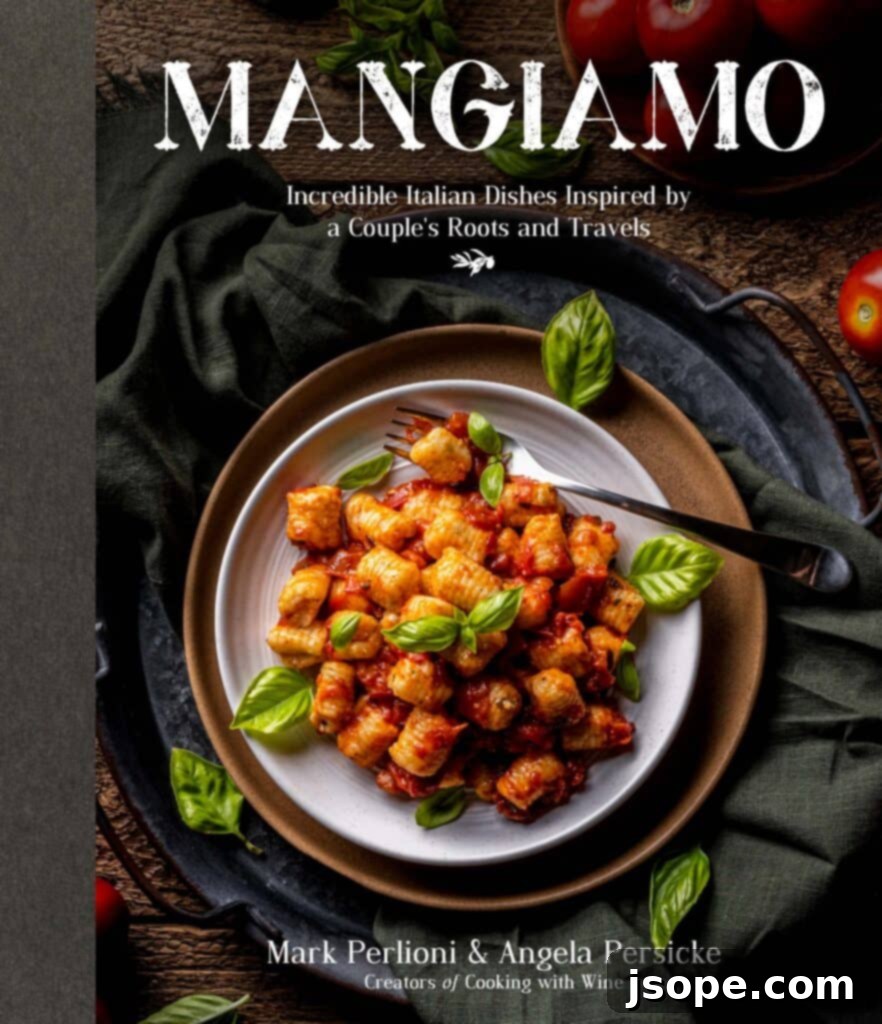
Explore More with the Mangiamo Cookbook
Dive deeper into the flavors of Italy with our acclaimed cookbook, Mangiamo. Featuring 60 mouthwatering Italian recipes, complete with stunning images, all inspired by our rich Italian heritage and extensive travels across Italy. Discover authentic dishes and culinary stories!
Order Your Copy Today →
Frequently Asked Questions
For an unparalleled flavor and heat, we enthusiastically recommend using Calabrian chili peppers, either as a paste or finely crushed in oil, as featured in this recipe. These chilies offer a unique balance of fruitiness, subtle smokiness, and a vibrant heat that stands apart. While cayenne pepper can add a good level of spice, it lacks the complex flavor profile of Calabrian chilies. Crushed red pepper flakes also provide heat but similarly miss the distinct fruity and citrusy notes. Other methods like adding your favorite hot sauce or a specialized seasoning blend (such as Cajun seasoning) are perfectly acceptable ways to customize the spice level, provided you enjoy their flavor contributions.
Yes, technically Calabrian chilies register significantly higher on the Scoville heat scale than jalapeños, often being around 10 times hotter. However, their perceived heat in dishes can be nuanced. When jarred in oil and sometimes with a touch of vinegar, as they often are, their intense heat is somewhat mellowed, allowing their rich, fruity flavor to shine through without completely overpowering the palate. This balance makes them incredibly versatile for adding a pleasant warmth rather than just raw spiciness.
Calabrian chili pepper paste offers a truly distinctive and complex flavor profile that goes far beyond simple heat. Imagine a vibrant warmth tempered by a beautiful fruitiness, with subtle hints of smokiness and even a slight natural sweetness. There’s often a delicate citrusy note that provides a perfect counterpoint to the spice, creating a wonderfully balanced and addictive flavor. This unique combination makes them incredibly versatile and a favorite ingredient for adding depth and character to dishes.
Achieving a consistently smooth and creamy Alfredo sauce hinges on a few key techniques. First, always cook your sauce over medium-low heat at most; high heat can cause dairy to break or curdle. Second, whisk the sauce frequently, especially when adding ingredients. Most importantly, when incorporating the cheese, remove the pan from the heat briefly until it stops simmering before whisking in the Parmigiano Reggiano. Once the cheese is thoroughly mixed, return the pan to very low heat, continuing to whisk constantly for about a minute to fully emulsify the sauce. It’s also crucial to use real, high-quality Parmigiano Reggiano and grate it yourself. Pre-grated cheeses often contain anti-caking agents that prevent them from melting smoothly, leading to an unwanted grainy texture.
Both “Garlic Parmesan White Sauce” and “Alfredo Sauce” are broad terms, especially given their Americanized forms, leading to significant overlap in many recipes. However, historically and fundamentally, there are distinctions. Traditional Alfredo sauce, as created by Alfredo De Lelio, contains only butter, Parmigiano Reggiano, and pasta water – no cream, and often no garlic in its purest form. The American version introduced cream and garlic. Garlic Parmesan White Sauce, on the other hand, typically refers to a broader category of creamy, cheesy sauces that often include a roux (butter and flour) as a base, making it a form of Béchamel sauce. This flour component generally makes Garlic Parmesan White Sauce thicker, suitable for uses like dipping sauces, baked pastas (like lasagna), or as a pizza base. Alfredo sauce, even in its Americanized form, is typically designed to be a bit thinner and primarily used for coating pasta, relying on cream and cheese for thickness rather than flour.
More Irresistible Pasta Creations
If you’re looking for other delectable recipes similar to this creamy, flavorful pasta, explore these options:
- Homemade Butternut Squash Ravioli Recipe
- Spicy and Creamy Penne alla Vodka with Chicken
- Spring Gnocchi with Sugar Snap Peas and Dill Cream Sauce
- Blackened Chicken and Broccoli Fettuccine Alfredo
Main Course Pairings for Your Pasta
These are some of our favorite meat, poultry, and seafood dishes that perfectly complement this Spicy Calabrian Chili Alfredo Pasta:
- Saltimbocca alla Romana
- Perfectly Seared Scallops
- Grilled Swordfish with Summer Gremolata
- Crunchy Chicken with White Wine Lemon Butter Sauce
📖 Recipe
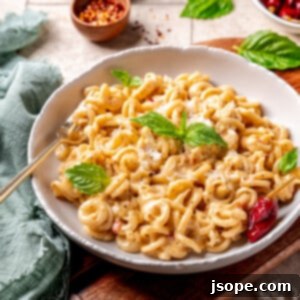
Spicy Calabrian Chili Alfredo Sauce with Trottole Pasta
Pin Recipe
Equipment
- 1 Large pot
- 1 Large frying pan
- 1 whisk
Ingredients
- 6 Tablespoons unsalted butter
- 3 garlic cloves minced
- 1 ½ cups heavy cream
- 2 teaspoons Italian seasoning
- 1 Tablespoon + 1 teaspoon crushed Calabrian chili pepper paste
- 1 teaspoon ground black pepper
- 1 ¾ cups grated Parmigiano Reggiano
- Kosher salt to taste
- 8 ounces pasta (such as trottole)
- Fresh basil to garnish (optional)
Instructions
- Begin by bringing a large pot of generously salted water to a rolling boil. While the water heats, proceed to prepare the sauce.
- In a large pan over medium heat, melt the butter. Add the minced garlic and cook for 1-2 minutes until fragrant, ensuring it does not brown.
- Whisk in the heavy cream, Italian seasoning, Calabrian chili paste, and ground black pepper. Once it reaches a gentle simmer, reduce the heat to medium-low, stirring often, and cook for 5 minutes.
- Remove the pan from the heat until the simmering stops. Whisk in the grated Parmesan cheese vigorously. Return the pan to very low heat, whisking constantly for 1 minute until the sauce is smooth and creamy. Continue to cook for 2 more minutes, then taste and adjust salt if needed.
- Add ample salt to the pasta water (it should taste like the sea) and cook the pasta until al dente according to package directions. Before draining, reserve one cup of pasta water. Drain the cooked pasta and transfer it directly to the pan with the sauce. Stir thoroughly to coat every piece of pasta. If the sauce is too thick, gradually add a tablespoon of the reserved pasta water at a time until the desired consistency is achieved. Serve immediately, garnished with fresh basil if desired!
Nutrition
Important Food Safety Guidelines
Ensuring food safety is paramount when cooking. Please adhere to these guidelines:
- Always cook food to its minimum internal temperature to ensure harmful bacteria are destroyed. For most poultry, this is 165 °F (74 °C).
- Prevent cross-contamination by never using the same utensils or cutting boards on cooked food that previously touched raw meat or poultry without thorough cleaning.
- Wash your hands thoroughly with soap and water after handling raw meat, poultry, or seafood.
- Avoid leaving perishable food sitting out at room temperature for extended periods (typically no more than two hours).
- Never leave cooking food unattended on the stovetop or in the oven.
- When sautéing or frying, use oils with a high smoking point to prevent the formation of harmful compounds.
- Ensure you always have good ventilation when using a gas stove to mitigate indoor air pollution.
For more comprehensive information and guidelines, please refer to USDA.gov.
